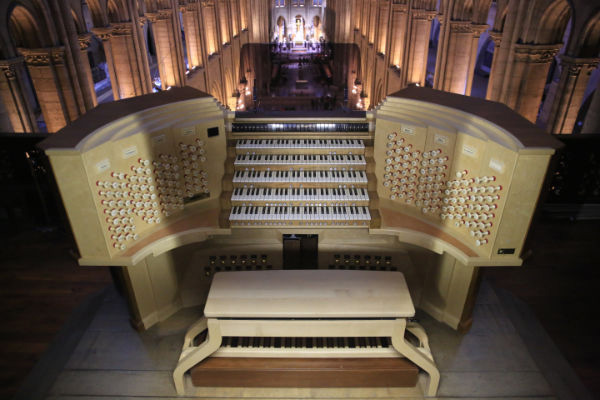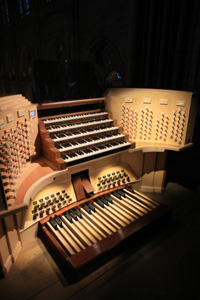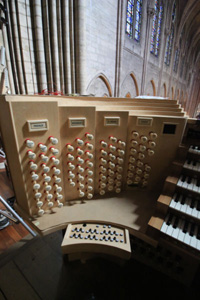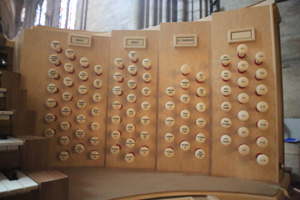


Activates the predefined pedal division in two parts on all the Cavaillé-Coll Pedal stops and the "CHAMADES" allocated to the Pedal.
Adjustable PEDAL DIVISION: Bass = CAVAILLE COLL pedal + CHAMADES allocated to the Pedal. - Trebble = PEDALCOUPLER in 8 & 4
When activation of PEDAL DIVISION + RESONANCE PEDAL : There is the Cavaillé-Coll Pedal and the Resonance and also the stops of chamades allocated to the Pedal in the Bass part of the pedalboard and only the pedalcoupler in 8 and 4 in the trebble part.
When activation at the same time of PEDAL DIVISION + RESONANCE/RECIT + PEDALCOUPLER RECIT : there is the resonance in the trebble part of the pedalboard. It is the same if the Resonance is allocated on any keyboard which is coupled with the pedal : there is the resonance in the trebble part of the pedalboard.
When activation of PEDAL DIVISION + RESONANCE PEDAL + RESONANCE ON KEYBOARD X + PEDALCOUPLER OF KEYBOARD XBass part of the pedalboard : CAVAILLE COLL pedal + RESONANCE, Trebble part: the pedalcoupler in 8 and 4 and, so, the resonance stops play also in the trebble because of the pedalcoupler on the keyboard X on which is allocated the Resonance.
When activation of PEDAL DIVISION + PEDALCOUPLER in 4 + PEDALCOUPLER SOLO, the pedalcoupler in 4 goes on beyond the division for the pedal stops. Example : division between SI 1 and DO 2. We play the 1st Sol and the 2nd Fa : the 1st Sol plays the Cavaillé Coll pedal stops (+ eventually the pedal chamade and the Resonance if they are allocated to the pedal) on this note. But the Cavaillé Coll pedal (+ eventually the pedal chamade and the Resonance if allocated to the pedal) will ALSO play on the 2nd sol. The 2nd Fa just plays the Solo stops.
This rocking tablet is reversible with a toe piston (left side, upper level)
The order and position of the division are recordable in the sequencer
In case of activation of PEDAL DIVISION with the PEDAL SOSTENUTO, the sostenuto is active only on the Bass part.

Activates the predefined pedal division in two parts : Bass part : Cavaillé Coll pedal + Pedalcoupler in 8 & 4, trebble part : Chamades (chamades stops allocated to the pedal)
This fonction regarding only the chamades allocated to the pedal, laying on the left panel of the stops, it has been decided to call it « Coup Cham PED » (pedal chamades division) because it concerns only these chamade stops.
The tablet (2nd tablet) in the fronton is so called : Coup Cham / PED
Its use is the same as for the pedal division and is done with an equivalent device.
The resonance allocated to the pedal, as for the pedal DIVISION, just plays in the Bass part. It is the same for the sostenuto.
In case of simultaneous use or wrong use of Pedal Division and chamades division, the Pedal Division has the priority and excludes the other function. There is no forced rocking of the tablet "Coup Cham PED".
This rocking tab is reversible with a toe piston (left side, upper level)
The order and position of the division are recordable in the sequencer
The number of buttons and so, of notes able to be selected, is 18 (Sol 1 à DO 3 included). There are two ranks of 18 bright buttons for the selection of the notes : one for the Pedal Division (upper rank), one for the Pedal Chamade division (lower rank).
These buttons are lying in the left drawer under the keyboards
3. PEDALE/GRAND ORGUE : allocates to keyboard I only, all the Cavaillé-Col pedal stops and the chamades allocated to the Pedal
4.Tirasse GO : Pedalcoupler in 8 of keyboard I
5.Tirasse PO : Pedalcoupler in 8 of keyboard II
6.tirasse RE : Pedalcoupler in 8 of keyboard III
7.Tirasse SO : Pedalcoupler in 8 of keyboard IV
8.Tirasse GC : Pedalcoupler in 8 of keyboard V
9.Tirasse GO 4 : Pedalcoupler in 4 of keyboard I
10.Tirasse PO 4 : Pedalcoupler in 4 of keyboard II
11.tirasse RE 4 : Pedalcoupler in 4 of keyboard III
12.Tirasse SO 4 : Pedalcoupler in 4 of keyboard IV
13.Tirasse GC 4 : Pedalcoupler in 4 of keyboard V
14.Sostenuto : Activates all the sostenuto selected, reversible with a toe piston (right side)
15.INVERSION POSITIF : inversion between keyboard I et keyboard II (the keyboard "great organ" becomes the 2nd keyboard)
16.PO / GO : Coupler in 8 of POSITIVE ON GREAT-ORGAN
17.RE / GO : Coupler in 8 of RECIT ON GREAT-ORGAN
18.SO / GO : Coupler in 8 of SOLO ON GREAT-ORGAN
19.GC / GO : Coupler in 8 of GREAT-CHOIR ON GREAT-ORGAN
20.RE / PO: Coupler in 8 of RECIT ON POSITIVE
21.SO / PO: Coupler in 8 of SOLO ON POSITIVE
22.GC / PO: Coupler in 8 of GREAT-CHOIR ON POSITIF
23.SO / RE: Coupler in 8 of SOLO ON RECIT
24.GC / RE: Coupler in 8 of GREAT-CHOIR ON RECIT
25.GC / SO : Coupler in 8 of GREAT-CHOIR ON SOLO
26.PS / GO 16 : Coupler of POSITIVE in 16 ON GREAT-ORGAN
27.RE / GO 16 : Coupler of RECIT in 16 ON GREAT-ORGAN
28.GC / GO 16 : Coupler of GREAT-CHOIR in 16 ON GREAT-ORGAN
29.RE / PO en 16 : Coupler in 16 DU RECIT ON POSITIVE
30.RE / GO en 4 : Coupler in 4 DU RECIT ON GREAT-ORGAN
31.RE / PO en 4 : Coupler in 4 DU RECIT ON POSITIVE
32.Octave / Gen. : put in 16 on I (ou II if inversion activated n°15) all the couplers in 8 called on the GREAT-ORGAN ; it doesn't put in 16 the intermediate couplers
33.Acc. gen : Activates all the intermediate couplers (cascade) on one level.
34. tutti
It is reversible with the toe piston "Tutti" laying itself on the right side, lower ranks, the last piston on the right.
OTHER INFORMATION
When a keyboard is coupled on itself in 16 or 4 or coupled with another keyboard, it regards all the active stops of the keyboard, including the "moving" stops.
Example 1 : if the stop "Cornet of Récit" is pulled on the GO panel : when GO is coupled on itself in 16 in 4, it concern also this Cornet as it is activated on the GO.
Example 2 : if the stop "Hautbois of Récit" is pulled on the POS panel, when the couplerII/I in 16 is active, there will be the Hautbois in 16 on the 1rst keyboard.
APPELS RESONANCE : the stops "Cornet et Hautbois" of the classical "Récit" (basically allocated to the keyboard III) follow the keyboard III when it's coupled with the keyboard II or I, or the pedal (if pedalcoupler is pulled), it is the same thing for the RESONANCE :
So, if the RESONANCE is allocated on a keyboard X, when the keyboard X is coupled with another keyboard Y, the Résonance will follow on the keyboard Y, including with the function PED/GO
Example : the Resonance is on keyboard SOLO (RES/SO) : if the coupler IV / I is selected, the Résonance will play on the 1rst keyboard
Example : Resonance on "Récit (RES/REC) ; if coupler III / I in 16 is selected, the Résonance will play in 16 on the 1rst keyboard
23 buttons :

Remark : There are two types of Sostenuto :
When the 2 sostenuto are selected, only the sostenuto by replacement is active. these functions sont recordables in the sequencer
19 buttons :
7 buttons :
9 buttons :
5 buttons :
When this function is active, a push on any button of combination (button or toe piston) activates the next combination.
Deactivates all the buttons under the keyboards, except the General Cancellor "RG". It doesn't concern either the toe pistons above the pedalboard or the tablets of the fronton.
These buttons of combination sequencer for the assistant are under the console from left to right :
26 pistons, None of the pistons buttons is equipped with indicator light
Left side
From left to right : Upper::
Left side
From left to right : Lower
- CRESCENDO PEDAL : Acting at the same time as expression of Resonance (when the Resonance will be provided with a swell box) : if the bright button CRESCENDO is active, this pedal activates the crescendo otherwise it activates the swell box
- PEDAL EXPRESSION RECIT
Right side
From left to right : Upper :
From left to right Lower :

Composition :
Left side :
| Pedal - 32 notes | Resonance - 56 notes | Great-Organ - 56 notes | Positive - 56 notes |
| Principal 32' | Bourdon 16' | Violon-Basse 16' | Montre 16' |
| Contrebasse 16' | Principal 8' | Bourdon 16' | Bourdon 16' |
| Soubasse 16' | Bourdon 8' | Montre 8' | Salicional 8' |
| Quinte 10 2/3 | Prestant 4' | Bourdon 8' | Flûte harmonique 8' |
| Flûte 8' | Flûte 4' | Flûte harmonique 8' | Bourdon 8' |
| Violoncelle 8' | Tierce 3 1/5' | Viole de Gambe 8' | Unda Maris 8' |
| Tierce 6 2/5' | Nazard 2 2/3' | Prestant 4' | Prestant 4' |
| Quinte 5 1/3' | Onzième | Octave 4' | Flûte douce 4' |
| Septième 4 4/7' | Neuvième 3 1/9' | Doublette 2' | Nazard 2 2/3' |
| Octave 4' | Flûte 2' | Fourniture harmonique II-V | Doublette 2' |
| Contre-Bombarde 32' | Tierce 1 3/5' | Cymbale harmonique II-V rgs | Tierce 1 3/5' |
| Bombarde 16' | Larigot 1 1/3' | Bombarde 16' (au C1) | Fourniture V rangs |
| Basson 16' | Flageolet 1' | Trompette 8' | Cymbale V rangs |
| Trompette 8' | Fourniture III rangs | Clairon 4' | Clarinette basse 16' |
| Basson 8' | Cymbale III rangs | chamades GO : | Cromorne 8' |
| Clairon 4' | Voix humaine 8' | Trompette 8' | Clarinette aiguë 4 |
| chamades GO : | Basson 16' | Clairon 4' | |
| Trompette 8' | Basson 8' | Cornet Récit (au 3ème ut au GO) | POS en 16 |
| Clairon 4' | Chimes | ANN Pos en 8 | |
| chamades Récit : | GO en 16 | POS en 4 | |
| Trompette 8' | Tremblant | ANN GO en 8 | |
| Clairon 4' | GO en 4 | ||
| Régale 2/16 |
Right side :
| Récit - 56 notes | Solo - 56 notes | Great-Choir - 56 notes | (no name) - 56 notes |
| Quintaton 16' | Bourdon 32' | Principal 8' | Appel Résonance sur GC |
| Diapason 8' | Principal 16' | Bourdon 8' (a) | Appel Résonance sur Solo |
| Viole de Gambe 8' | Montre 8' | Prestant 4' (b) | Appel Résonance sur Récit |
| Voix céleste 8' | Flûte harmonique 8' | Nazard 2 2/3' (c) | Appel Résonance sur Positif |
| Flûte traversière 8' | Quinte 5 1/3' | Doublette 2' (d) | Appel Résonance sur GO |
| Bourdon céleste 8' | Prestant 4' | Tierce 1 3/5' (e) | Appel Résonance sur Pédale |
| Octave 4' | Tierce 3 1/5' | Septième 1 1/7' | C1 |
| Flûte octaviante 4' | Nazard 2 2/3' | Piccolo 1' | C2 |
| Quinte 2 2/3' | Septième 2 2/7' | Plein jeu III-V rgs | C3 |
| Octavin 2' | Doublette 2' | Tuba Magna 16' | C4 |
| Bombarde 16' | Cornet II-V rgs | Trompette 8' | C5 |
| Trompette 8' | Fourniture II rgs (32') | Clairon 4' | C6 |
| Clairon 4' | Fourniture V rgs (16') | Cornet (appel des jeux a,b,c,d,e) | C7 |
| Basson-Hautbois 8' | Cymable V rgs | C8 | |
| Clarinette 8' | Cromorne 8' | GC en 16 | C9 |
| Voix humaine 8' | chamades GO : | ANN GC en 8 | C10 |
| Récit classique : | Chamade GO 8' (emprunt I) | GC en 4 | C11 |
| Cornet (à partir du 2ème fa) | Chamade GO 4' (emprunt I) | C12 | |
| Hautbois 8' | Hautbois 8' Récit | C13 | |
| chamades Récit : | Cornet Récit (à partir du 2ème fa) | C14 | |
| Basse Chamade 8' | |||
| Dessus Chamade 8' | SOLO en 16 | ||
| Chamade 4' | ANN SOLO en 8 | ||
| Chamade Régale 8 | SOLO en 4 | ||
| chamades GO : | |||
| Basse Chamade GO 8' | |||
| Dessus Chamade GO 8' | |||
| Chamade GO 4' | |||
| Trémolo | |||
| Récit en 16 | |||
| ANN Récit en 8 | |||
| Récit en 4 |
On the right : the 6 registers of "calling the Resonance" on each keyboard and pedalboard
14 drawstops for the "enhanced combinations" = 2 vertical colons of 7 registers
Naming ; C1, C2, C3 etc .. until C14
The principle of a enhanced combination :
We activate "Pos/Great-Organ", in accord or any interval (the tierce or the major, minor second etc.) from C1 to G2 or any other note. Then, we can activate also Récit/Great-Organ or another keyboard, in any interval from G#3 to G4 or another note etc. So we can, couple between them, all the keyboards split at any chosen note and according to the chosen interval.
The number of possible creation of enhanced combination is important. The configuration of all this procedure is made today by writing directly these functions in the program. The engineers of Eltec Automazioni, develop at the moment, the complementary interface on the screen Digitouch so that the organists can do themselves this procedure directly.